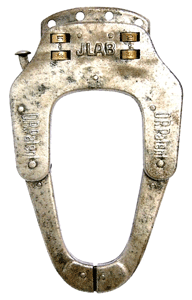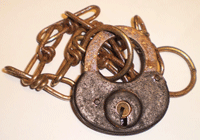The earliest methods for locking velocipedes and bicycles were a padlock and a steel chain of a suitable length. 100 years later, this combination has come back into use. The earliest serial manufacturers of bicycles were found in Germany, France, the UK and the US, and these are also the places where the first, and the most specially designed, bicycle locks were made.

Steel lock from Germany from the early 20th century
These locks are designed for locking the rear wheel between the spokes, with the lock mounted directly on the stay underneath the seat.
American bike locks
Velocipede and bicycle locks made of brass or steel were exported from the United States. The locks were placed around one of the front or rear fork arms and a couple of spokes, or around a pedal bar and the frame.
Bike locks with chains
The first velocipede locks consisted of a freestanding steel chain of a practical length and a steel padlock. The two end links of the chain were locked together with the shackle of the padlock. The chain allowed you to lock the bike to an immobile structure. The chains could be bought with or without a padlock.

The lock concept developed into a padlock type with two shackles, one permanently connected to a sturdy chain and the other which opened and closed around a link at the other end of the chain. This lock had a very simple key.
More recent steel bike locks
In the 1920s, companies such as the German Damm & La and GALVANOS made bike locks of pressed steel, intended for locking the back wheel.
In Sweden, such locks were not made until the 1930s. The earliest locks were made by Optimus. There were several different types, designed to lock the spokes of the back wheel while mounted directly onto the frame under the bike seat. But the first locks were not particularly reliable. They were easy to break open with a hammer or another tool.
On some makes of bike, the round locks also locked a steel toolbox, which was mounted on the carrier.
Optimus
The Optimus (Latin, meaning best) company was founded in 1899 by three engineers: Peter Östberg, Carl Neiglich and Carl Böös. Initially, they made paraffin stoves and blowtorches in Östberg’s workshop on Hantverkargatan in Stockholm. His cousin Anton Tamm became president of the company and bought a large manor (Stora Vilunda), on which Optimus built its modern factory in 1907. That year a new director took over, Gilbert Otterström, who remained in that position until 1933. The factory went online in 1908, and by 1910 employed 150 people.
It wasn’t until the 1930s that locks (and storm lanterns) were introduced to the product range. They were padlocks made of pressed steel in a variety of sizes and models. They also sold imported locks. The company made its own padlocks, but it also imported some, both padlocks and door locks, from the Independent Lock Company, ILCO, with plants in Fitchburg, Massachusetts. Optimus was the importer and sole retailer of ILCO’s range worldwide outside the US and Canada. A product catalogue with Optimus’s own padlocks and ILCO’s padlocks and door locks was printed in Swedish in Stockholm in 1931.
As bicycles grew in popularity, the company also began to make bike locks of pressed steel in the 1930s.
With the Second World War, kerosene was rationed and exports were canceled, but the growing demand for padlocks, above all for the military, saved the company.
The plant in the municipality of Upplands-Väsby closed in 1983, and manufacturing was moved to the province of Småland. Currently (2010), the company only makes camping equipment under the name Optimus International AB.
Today’s locks and security solutions
Welcome to ASSA ABLOY’s product pages for more information about today’s locks, access control, mobile keys with NFC, door automatics and more. In the ASSA ABLOY solution pages you can experience lock and security solutions for any door opening.